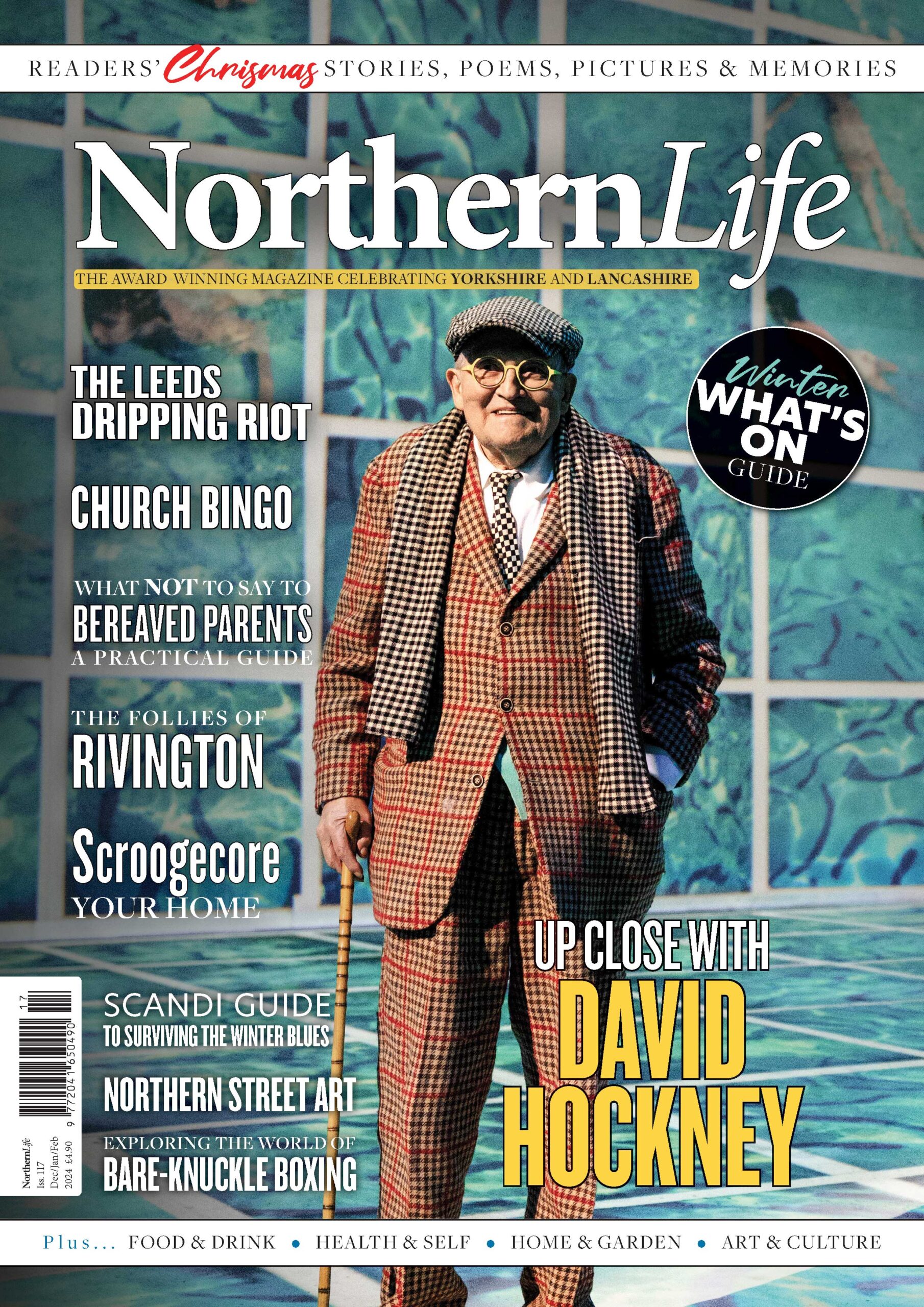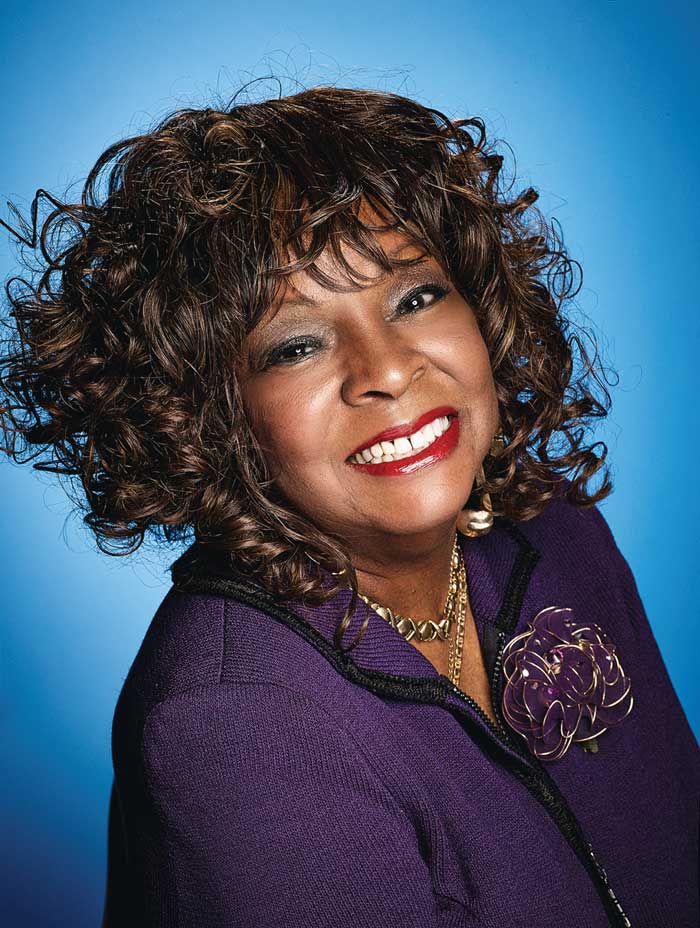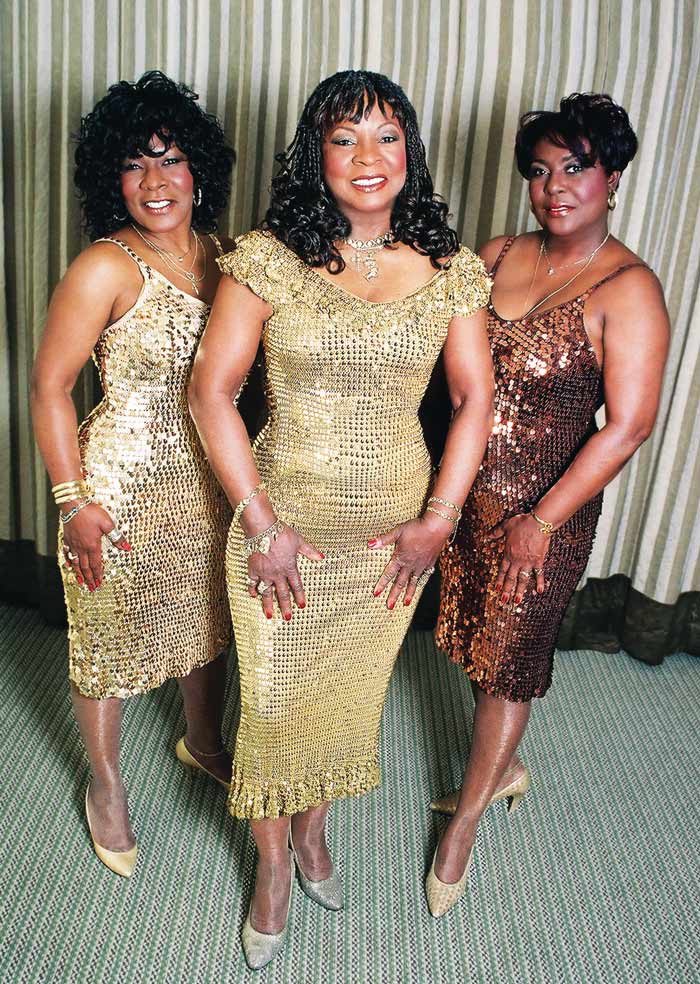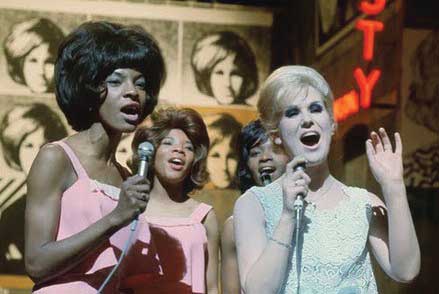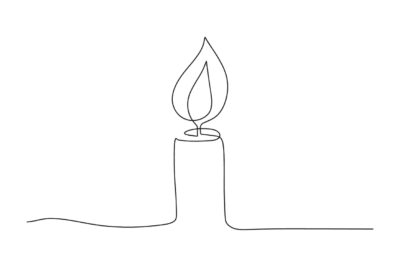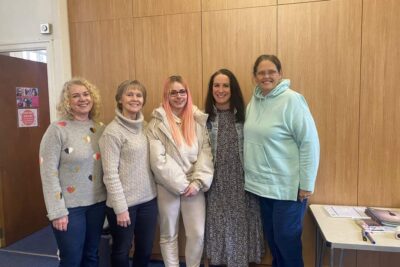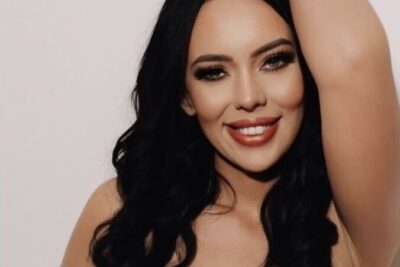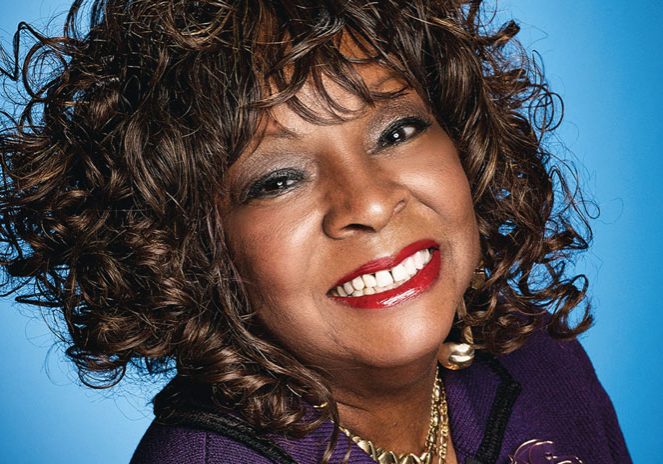
We chat to Martha Reeves ahead of Northern tour dates
by Karen Shaw
They had umpteen hits, including ‘(Love is like a) Heat Wave’, ‘Quicksand’, ‘Nowhere to Run’ and ‘Jimmy Mack’. But it is 1964’s chart-topping, endlessly covered anthem ‘Dancing in the Street’ for which Martha and the Vandellas will be remembered. As a star of the Tamla Motown stable, Martha helped to break down racial barriers in those days, and after serving on Detroit City Council she returned to full-time performing. As Martha prepared for her latest tour including some northern gigs, Karen Shaw caught up with her for a fascinating interview.
- Martha Reeves with her sisters the Vandellas
It’s three minutes to 3pm UK time and I didn’t manage much sleep the night before. I’ve been far too excited. In three minutes I’m due to interview one of my musical icons, Martha Reeves. It wasn’t until I started researching her that I realised how much we had in common. I’ve spent the last two hours blasting out her hit songs while prancing around the office with an empty water bottle for a microphone. I’m pretty sure delirium is setting in and I know for sure that I’m driving my fellow work colleagues mad, but who cares, this is Martha.
“Martha, I don’t know if you’re aware, but we have so much in common,” is my opening line. “My eldest daughter is named Ruby and…”
“Oh, my mama’s name was Ruby,” she drawls. And when I go on to tell her my youngest daughter is called Martha, she sharply inhales and exhales with: “What? No way!” Laughing, she goes on to say: “We should be sisters.” I couldn’t agree more.
That’s a good start. Martha reckons we could be sisters… Martha’s first visit to the UK was in 1972 and 45 years on it’s a place she holds very dear.
“It’s a regular thing now; we’re in the UK two to three times a year. The amount of love we receive for our music always makes me eager to return. The audiences are so faithful and have grown with us over the years, they tend to sing along to our songs when performing. The American market tends to go for the newest and freshest artists and many of the musicians use synthesised music whereas I prefer to work with live musicians. With live music it’s great because everyone has their own style and groove and we all work together to emulate the recordings the best way we can. Musicians bring a flavour with them, especially if they have good characters. It’s a true joy to work with them.”
Martha has recently released a Gospel Christmas album and will soon be performing a few tracks from her new album on her latest tour to get everyone in the Christmas mood.
When it comes to family, Martha is the third eldest out of 11 siblings and the Vandellas are her two sisters. This really is a family business. “I’ve been working with my sister Lois since 1968 and Delphine, my baby sister joined me in 1980. She describes performing with her two sisters, as “wonderful, they’re my mama’s babies.”
Music really does run through their veins, and Martha’s inspiration was her mum, who she still tries to emulate, “when I’m singing a ballad, I try to sing like her. She is the first voice that I really admired. She would dress up and sing to us, she always had a song; she loved Billie Holiday and would sing many of her songs often with a flower in her hair in the style of Billie. She never aspired to be a singer; she was too busy being a mum, she was beautiful. When she would sing a certain glow would come upon her. God rest her soul. My mom taught me how to remember poems and song lyrics. I’m the generation before TV, we used to sing along to the radio. The music in our house was always gospel so I didn’t start singing secular music until I was eleven. The whole family was in the church choir so we would practise all week ready for church on Sunday. I prayed to God to let me sing and he gave me a wonderful gift.”
From the age of three Martha was a regular little songbird in her grandad Elijah’s church, and on numerous occasions would win the talent competitions alongside her two brothers. “The prize for winning was chocolate covered cherries, and if I felt my brothers’ performances weren’t very good I wouldn’t allow them any candy!” she laughs.
- with Marvin Gaye
- with Dusty Springfield
- with Stevie Wonder
Her dad, who was also called Elijah, had played blues guitar with John Lee Hooker and on occasions would play guitar at church. “I believe that spirituality and the Blues are closely related, sometimes you can replace the words ‘Oh Baby, to ‘Oh Lord’”.
Martha grew up with a religious background; however it was in 1977 that she ‘gave her heart to the Lord’. “As a child you learn about God, and as an adult you take on another level of your faith.”
It’s no secret that in her early days of her musical career, Martha tended to ‘backslide.’ Out partying with other fellow musicians, many of her nights would be lost in a fog of drugs and alcohol.”
“When my re-birth came, I needed to repent. I needed to cleanse my spirit and become an adult. I had to throw away childish thoughts and put on a more respectable attitude to life, people and myself. That came after having two marriages annulled and having a child out of wedlock.
“I had courted my baby’s daddy for four years and was engaged at the highlight of my career. We’d had a fight, made up and then after our final argument, I discovered I was pregnant, which often happens. My parents must have fallen out a lot,” she jokes. “One of the best lessons in the world is to have seen my parents fighting, but then, always making up. They were married for 47 years and lived like the wedding vows they made, ‘until death do us part.’”
A month after giving birth to her son Eric, Martha came to England on the Georgie Fame tour. It was her father who said: “Well, Martha, you didn’t get the man, so you’ve got to go to work!”
“I was happy that my parents were there for me and offered to look after Eric while I was away, but I was equally unhappy to be leaving my new born child. Leaving him almost tore me apart.”
It was while Martha was in England that she penned her first solo song, Home to You. “I was staying at a B and B and woke in the middle of the night, I was all alone, missing Eric and crying so I picked up a pen and began writing. The words flowed, just like my tears. “Every song has an experience with it. I can’t pick a favourite song because they are all a piece of my life. When I was called into my first-ever audition I was so ill with the flu, but I went and sang Nowhere to Run and my voice was whiney to start off with but I really felt the music and after the audition I’d well and truly gotten rid of my flu. I felt it and I’m really thankful they gave me that song because they could have given it to any of the 30 artists that Motown discovered and made famous.
“I had a lot of things to do in recovering from a lifestyle that can come from being a performer. You can get yourself into a lot of trouble if your intentions aren’t in perspective. I enjoy looking back and imagining what my life could have been like if I hadn’t turned it round.”
And turn it round, she did. With a Masters’ degree in Religious Studies and Doctorate in Humanities, as Martha confirms, she’s now, “on the right track. I strive to be better and kinder than I was yesterday.”
Her southern soft tone exudes kindness, and despite all her academic and musical success, there’s no airs or graces with Martha. She may have the strength in her voice of a lion but when it comes to conversation she’s as humble as a church mouse.
“Humbleness comes from the way you’re treated and the way you’re raised. Mom and dad were past-masters. I remember my mom saying ‘You do the best you can the first time and then I won’t ask you to do it again. There’s no need to be sorry when you’ve done the best you can.’ That was drilled into me all my life and throughout my life I have adopted that philosophy. She would always say; ‘You can do it!’
“There’s no need to be ashamed or embarrassed if you have done the best you can do. I was brought up to be kind to my family and neighbours, to always be charitable and always have faith.
In 1965 when the Tamla Motown Revue came to the BBC at Dusty Springfield’s invitation, many people in the UK were not familiar with acts like The Miracles and The Supremes.
“I’d been friends with Dusty for a while and when she asked for me and the Vandellas to go on the show, Berry Gordy (founder of Motown) saw it as a chance for him to get all his acts on the BBC so he brought the whole Motown family over including Earl Van Dyke and his band. I’d never performed with Earl’s band live before as they were studio based, they never left the studio. I got a chance to sing on live TV with Earl Van Dyke and then Dusty invited me to sing her hit record Wishing and Hoping as a duet with her. To me, it was just a happy time singing with my sister.”
Once in the Motown ‘family’, Martha was shown the ropes and like all the other artists undertook a four-year training course focusing and honing her performance skills. Part of Gordy’s grand plan had been for his black soul singers to appeal to multi-racial audiences, and he famously put his rising stars through ‘artist development’ classes. This gave them, as Martha puts it, “a certain poise, class and Motown signature. We went in saying ‘We just want a hit record; we don’t care nuthin’ ‘bout singing for kings and queens and lords and ladies.’
“But I can now say we’ve all had royalty in our audience.” Their Motown tutors, Martha says with heart-breaking sincerity, “made us socially acceptable. We were the first generation of people who were allowed to sit in a restaurant and eat like people. We saw the change with the civil rights movement. We had to behave properly. We didn’t know how to sit at a counter with a knife and fork and eat properly. We were taught how to behave.”
Effectively they were Motown missionaries and in 1962 Martha took part in the first Motown Revue in her racially segregated home state of Alabama.
I’d read a story about how Stevie Wonder’s tutor who was Caucasian had to go into restaurants and order food for the Motown artists.
“Yeah, that’s true,” replies Martha. No sooner has she uttered those words, she interrupts: “Oh my, someone’s calling me who’s very important. I’ll have to call them back.”
And then she continues…
“He’d go in and order 30 hotdogs and hot chocolates with the five-dollar daily allowance we were given. The food would be cold by the time we got them. But we won. We overcame it and went on to audiences anticipating our arrival. On one occasion at a Motown gig in Alabama I remember Smokey (Robinson) ask the bodyguards to step back and not hit another person with a baseball bat for wanting to dance.
“These bodyguards didn’t care and would club people in the head with bats. That was eventually outlawed and I’m so glad. It didn’t matter what colour you were, if you so much as moved they would hit you! Smokey just stopped the gig and said ‘Hey you two guys, stand back and don’t hit another person in the head with those clubs. This is dance music and we want to have fun.’
“The bodyguards left and the audience jumped out of their seats and danced. There were white people on one side of the room and black people on the other and by the end of it they were all dancing together. We broke down the barriers. Music is my medicine. It’s my lifestyle. It’s my love. It’s what I do.”
Before she began performing to millions, Martha had worked as a secretary in the Motown office and remembers vividly the first time she met musical icon Stevie Wonder. While waiting for his audition he’d trashed my office, emptying the waste paper basket to use as bongos and tapping on her typewriter like he would a keyboard. He then went to the telephone and started making noises with that, so I was saying, ‘Give me the phone, kid – you’re gonna call Russia!’ I was there when he took his audition. He sat at the grand piano, and started playing. I was amazed how well he could play that grand! Then he moved onto the drums and played them like he knew Gene Krupa! Berry remarked, ‘This kid is a wonder!’ And I think that’s how he got his name.”
It was her Motown colleague Marvin Gaye who suggested Dancing in the Street would be perfect for Martha to sing. At first Martha wasn’t keen. As she puts it: “I didn’t want to dance in the street, I wanted to be dancing on stage!”
She goes on to tell me a tale about how as a child they would block the street off once or twice a month and all the neighbours and family would be out there dancing, literally, in the street. “We would all be there,” laughs Martha, “dancing on those cobblestones with the record player on the sidewalk and we would dance until the sun went down.”
Returning to Marvin Gaye, she recalls: “Marvin could be very moody, but he could be very romantic.”
Did I detect a hint of adoration, when she speaks his name? Should I have heard it on the grapevine?
“Oh, no,” laughs Martha. “He didn’t like me! I sang on his first album and I don’t even think I got paid. He used to hide his handsome face under his hat and sunglasses. We were all in awe of him, he was so talented. He was shy and very introverted. Marvin and Smokie had that same trait, both very serious about their music. They were masters of music, not only did Smokey write My Girl he also wrote My Guy. So being around those geniuses…I was in heaven.”
When I ask her opinion on Mick Jagger and David Bowie’s version of Dancing in the Street, she immediately replies, “I was upset!” and quick as a flash, I interrupt her.
“Me too,” I agree, “it was awful!” It’s days like this I really wish I’d held my tongue. She hadn’t finished talking. She goes on to say: “I never had a video and I would have looked good dancing with them on the video, because I could dance! They did a wonderful job.”
At this point I’m slowly and quietly recoiling with embarrassment I swiftly move another firm favourite of mine, the hit song Nowhere to Run was said to reflect the soldiers’ feelings in conflict during the Vietnam War.
“When Robin Williams called out our name in the film Good Morning Vietnam it was to represent the feeling that the soldiers’ had for the song. It made it clear that they used Motown’s music, especially Nowhere to Run to get through the war. The song Jimmy Mack was written in the time of the Korean War but it was too light-hearted to be released. The Vietnam War was so closely related but we kind of had a different feeling about that war and our guys going away and coming back. Some of them never did and that’s what Jimmy Mack represents.”
Motown stands for more than just the history of music. It’s remarkable legacy is a reflection of the hard work of dedicated individuals like Martha, who continued to overcome obstacles to achieve world-wide success in a time of grave uncertainty.
Martha was and continues to be so much more than a performer, she is a lady who along with her fellow ‘Motown missionaries’ changed the world of music and broke down racial barriers. I’m looking forward to meeting her when she returns to the UK, I’ll be there with a smile as wide as the Mississipi and a box of chocolate covered cherries, after all, it’s the first time I’ll be meeting my newly acquired sister.
Northern tour dates for Martha Reeves and the Vandellas include:
- The Sage, Gateshead, December 12th
- Fibbers, York, December 13th
- Hangar 34, Liverpool, December 15th
- Manchester Academy, December 16th
- Warehouse 23, Wakefield, December 17th
